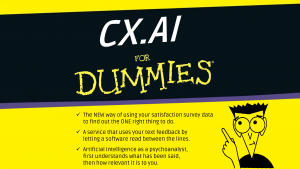What is Driving Customer Experience and How to Improve It?

What is driving Customer Experience and how to improve it?
How do you find out what’s driving customer experience and what should you do to improve it?
What do companies do to find out what drives CX? It is basically you ask an open question. Why did you rate this way? That’s basically what was advised by the inventors of NPS.
Of course other companies try to ask closed-ended questions. Basically they ask, how good are we at quality? How good are we in speed, at quality of service or support . This is typically what less and less companies are doing, because you need to torture your customers with lengthy questionnaires. But actually what you want to do is to have a one minute questionnaire and ask everyone.
That’s basically what you can do with the NPS approach. That’s basically the key method companies are using. But actually this message is broken and it always has been broken. It’s useful to do it. It’s also useful to have this customer feedback and give it to the frontline. But…
If you have not so many customer feedback, it’s the only thing you can do. You can work with it, but actually this method relies on a big misunderstanding.
The misunderstanding is, you ask the customer, why did you rate that way? Then you simply count, when you do the analytics. What’s the most often mentioned topic and obviously the most mentioned critique must be the most important one to be fixed and the most mentioned positive thing is what we do wonderfully. Right?
Actually this assumption is wrong.
Why do we know it? Because we can take what people are saying. We quantify that basically. Producing binary variables, and then predicting whether or not we can predict the rating and the outcome. What you see is that the true impact of topics – what people are saying – is nearly uncorrelated with the frequency of mentioning.
You can, we’ll explain this phenomenon.
Once you accept that there are even other things, what companies are doing, to mitigate this. They split the frequency and compare what detractors say versus what promoters say. Even this is prone to so-called spurious correlation, spurious correlation is basically a correlation, which is not causal , for an example – if you look at the C-suite of companies, they have typically much larger shoe sizes. You split C-suite versus other employees. And so you see that they have larger shoes.
So is shoesize now truly driving the likelihood to become a company leader? No. In this case it’s of course its ridiculous. The reason: typically leaders are still men, not women, and they have larger shoes. So there are cool correlating facts, which not necessarily are the cause, there is simply another correlation or another expression or another outcome of a causing topic.
You can find out which one is causal, mutually explaining outcomes and therefore you need modeling analytics and multivariate modeling. It’s basically not possible with simply splitting, slicing and dicing data.













